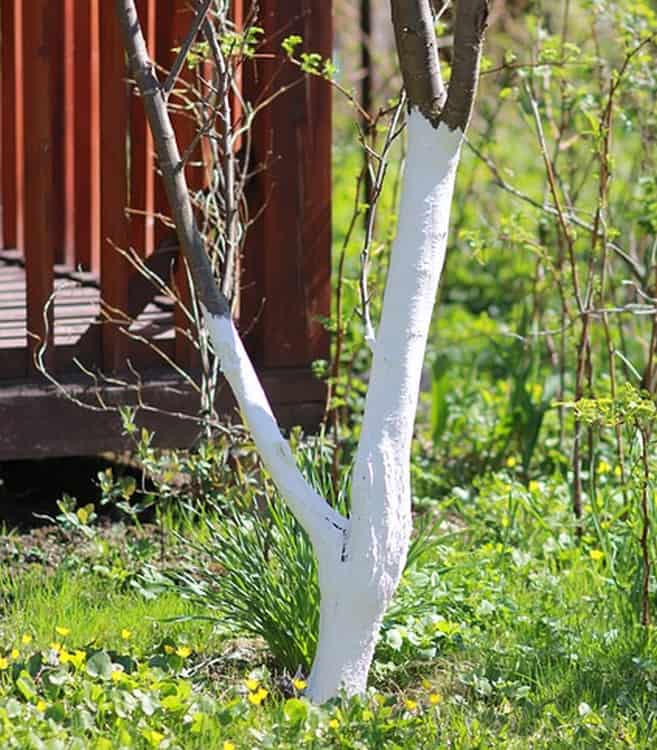Whitening the trunks of fruit trees and shrubs is an extremely important maintenance procedure. It is performed in the garden during winter. The purpose of bleaching is to keep trees and shrubs in good condition and protect them from bark damage. Every garden owner should perform this procedure once a year, preferably in December or early January.
Why is it so important to whiten the trunks?
During the winter period there is often damage to the bark or thick branches, they then begin to crack. This is caused by the intense heating of the trunks during the day by exposure to sunlight. Trees or shrubs then no longer have leaves, so the sun has a direct effect on the bark.The high temperature leads to the awakening of cells and stimulation of sap circulation. Overnight, the temperature often drops below zero, and then the awakened subcortical layer of the tree begins to freeze, and the bark shows longitudinal cracks. To avoid this, we need to paint the trunks of fruit trees and shrubs with lime . The whitened bark heats up much less, so there is no formation of wounds. Most often, bark cracks are caused by temperature fluctuations in trees such as cherries, plums, apple, cherry and pear trees.

When is it necessary to carry out the procedure of bleaching the stems of fruit trees and bushes?
We can start painting fruit trees and bushes from mid-December. However, the recommended date to perform such a procedure is January (8-23.01). It is during this period that there is frost at night, while during the day the sun intensively heats the bark. Liming of the bark should be done on a suitable day. There should be no rain, wind or sun at that time. The temperature should preferably be around 5 degrees. We can cover trees and shrubs with lime until late January/early February (24.01-15.02). Whitening the trunks at other times will no longer bring any results and will simply be unnecessary.
With what and how to carry out the bleaching of trunks?
Usually for bleaching trees one reaches for lime. This is a fairly simple procedure to perform, however, it is good to familiarize ourselves in advance with the steps we need to take. We also need to know what to do so that the lime is not washed away too quickly by the rain. For the whitening of tree trunks and fruit bushes will work perfectly lime milk. So we need to purchase ordinary quicklime, with which we prepare lime milk. Such an agent is used, among other things, in the construction industry. We need to dissolve the lime in water beforehand (2kg of lime per 10 liters of water). Importantly, if we do not want it to be quickly rinsed off the bark, we should add to it an agent that improves the adhesion of lime. This can be an additive in the form of starch made from potato flour or white emulsion paint. Starch is an effective natural additive that increases the adhesion of the whole mixture. Before applying to the bark of the tree, the lime should be mixed well. The bleaching procedure is carried out with a brush. The trunks of trees and shrubs, as well as thick branches, should be covered with lime. Importantly, let’s paint the south side a little higher, because here the trunks heat up the most, so there is the highest probability of the appearance of gangrene wounds. Of course, we do not need to prepare a special mixture ourselves, as we can purchase a ready-made product. Commercially available preparations for bleaching trees with increased adhesion are very effective agents. So the treatment does not need to be repeated after each rainfall, which is very convenient. It is worth betting on high-quality lime, from a trusted manufacturer.

